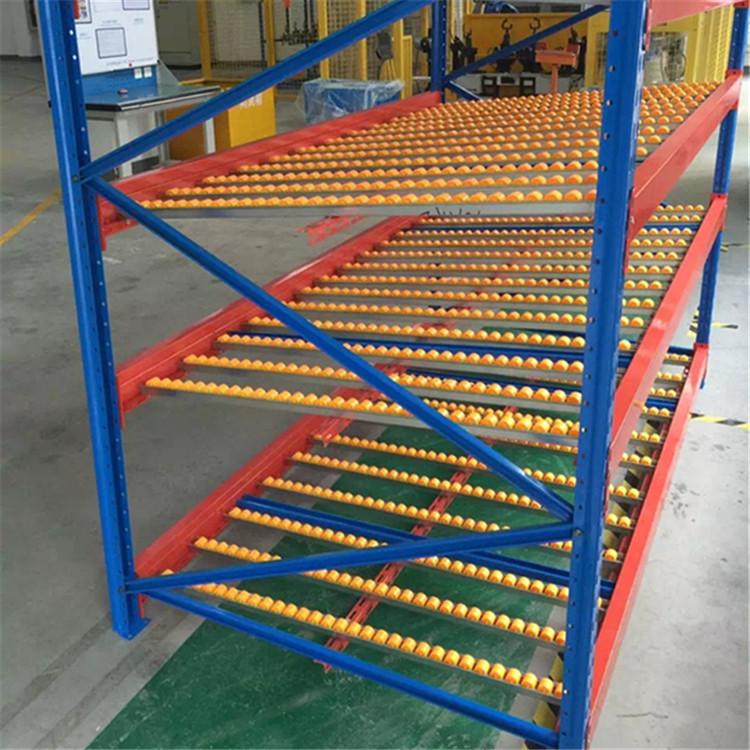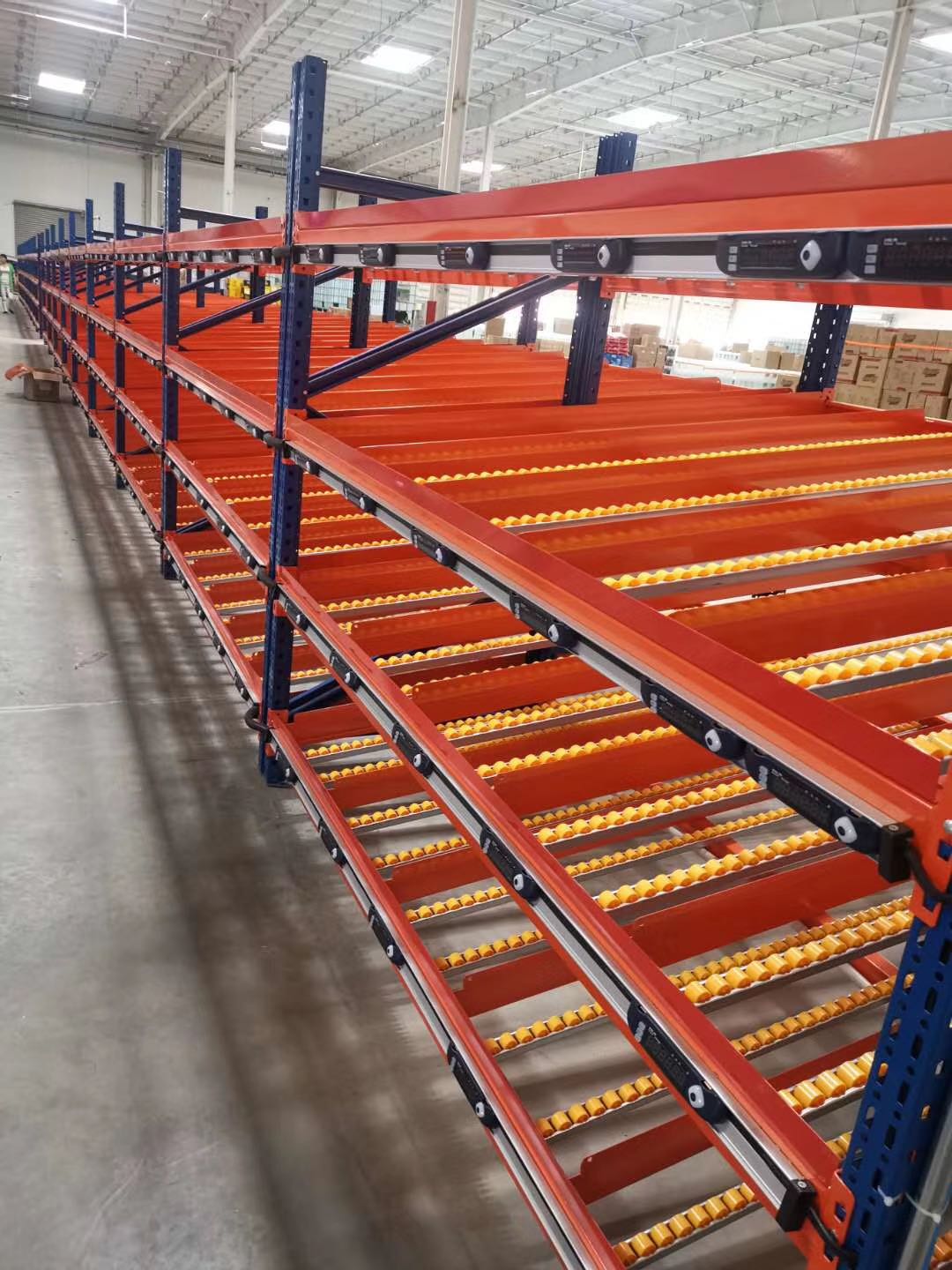In the relentless pursuit of warehouse efficiency and faster order fulfillment, selecting the right storage system is paramount. Among the specialized solutions available, flow through pallet racking stands out as a powerful method for managing high-volume inventory with specific rotation requirements. This system leverages the simple, undeniable force of gravity to create a dynamic storage environment where pallets literally flow from the loading end to the unloading end. Let's delve into the mechanics, benefits, and ideal applications of flow through pallet racking.

Understanding the Core Principle: Gravity in Motion
At its heart, flow through pallet racking is a high-density, dynamic storage system designed around the First-In, First-Out (FIFO) inventory methodology. Unlike static racking where pallets sit stationary until manually retrieved, flow through pallet racking uses inclined roller or wheel tracks installed within the rack structure. Pallets are loaded onto the higher end (the "back" or loading aisle). Gravity then takes over, gently moving the pallets down the slope towards the lower end (the "front" or picking aisle). As a pallet is removed from the front for picking or dispatch, the entire row of pallets behind it automatically advances one position. This continuous movement ensures the oldest stock (first in) is always the next to be picked (first out), making it ideal for products with expiration dates, batch codes, or those simply requiring strict stock rotation. The defining characteristic of flow through pallet racking is this uninterrupted flow facilitated by gravity.
Key Components of a Flow Through Pallet Racking System
A robust flow through pallet racking installation relies on several critical components working in concert:
Structural Frame: This forms the skeleton of the system, typically constructed from heavy-duty steel uprights and beams. It must be engineered to support the significant weight of fully loaded pallets across multiple levels and withstand the dynamic forces of pallets moving within the lanes.
Flow Rails (Rollers or Wheels): These are the heart of the movement. High-quality, low-friction rollers or wheels are mounted onto rails set at a precise incline. Roller tracks are often preferred for heavier loads or less rigid pallets, while wheel tracks can offer slightly lower rolling resistance. The choice depends on load weight, pallet type, and desired speed.
Braking Systems: Essential for controlling the pallet's descent speed and preventing collisions, especially at the end of the lane or during initial loading. Common solutions include:
Speed Controllers: Friction strips or devices integrated along the rails to moderate pallet speed.
End Stops: Robust brakes at the pick face designed to halt the lead pallet securely and absorb the impact of the following pallet.
Pallet Separators (optional): Used in some systems to ensure pallets remain adequately spaced during descent.
Lane Separators: Vertical guides running the length of each lane keep pallets centered and aligned on the tracks, preventing them from jamming against the rack structure or neighboring lanes.
Loading and Picking Aisles: Flow through pallet racking requires dedicated aisles on both ends:
Loading Aisle: Located at the higher end, where forklifts deposit pallets onto the flow lanes.
Picking/Dispatching Aisle: Located at the lower end, where forklifts or order pickers remove pallets as they arrive. This aisle typically experiences much higher traffic than the loading aisle.
Safety Features: Includes structural safety locks, rack protectors, clear signage, and often guardrails at the pick face to enhance operational safety.

Operational Advantages: Why Flow Through Pallet Racking Delivers
Implementing flow through pallet racking brings significant operational efficiencies:
Guaranteed FIFO Inventory Rotation: This is the system's primary strength. It eliminates the risk of older stock being buried behind newer stock, crucial for perishable goods (food, pharmaceuticals), items with limited shelf life (chemicals, cosmetics), or products subject to obsolescence (electronics, fashion). Consistent rotation minimizes spoilage and waste.
Increased Picking Efficiency and Speed: Pallets automatically advance to the pick face. Operators don't waste time searching for specific pallets or driving deep into racking bays. Picking occurs consistently at the same, easily accessible location in the front aisle, significantly reducing travel time and labor costs per pallet handled. Order fulfillment cycles are accelerated.
Enhanced Storage Density: Flow through pallet racking achieves significantly higher storage density compared to traditional selective pallet racking. By eliminating the need for multiple access aisles within the storage block (only requiring aisles at each end), it maximizes cube utilization. More pallet positions are packed into the same floor space.
Reduced Labor Costs: The automation provided by gravity dramatically reduces forklift travel distances and maneuvering time. Operators spend less time driving and more time on productive loading and unloading tasks. Fewer forklifts may be needed to handle the same volume, leading to savings on equipment, fuel, and maintenance.
Improved Safety: Reduced forklift traffic within the actual storage lanes minimizes the risk of collisions with racking. Operators primarily work in defined aisles at each end. The controlled descent of pallets also reduces the risk of manual handling injuries associated with retrieving pallets from deep within static racks.
Optimized Warehouse Layout: By consolidating high-volume SKUs into compact flow through pallet racking lanes, warehouse planners can free up valuable space for other operations, such as value-added services, cross-docking, or slower-moving inventory in selective racks.
Ideal Applications: Where Flow Through Pallet Racking Shines
Flow through pallet racking is not a universal solution but excels in specific scenarios:
High-Volume SKUs with FIFO Requirement: This is the sweet spot. Products with high turnover and strict rotation needs benefit immensely. Examples include beverages, packaged food, paper products, and certain automotive parts.
Perishable Goods Distribution: Cold storage warehouses for frozen foods, dairy, produce, and pharmaceuticals heavily rely on flow through pallet racking to ensure product integrity and minimize spoilage by strictly adhering to FIFO.
Beverage Distribution: The beverage industry, with its high volume and constant SKU rotation, is a major user. Flow through pallet racking efficiently handles pallets of cans, bottles, and kegs.
Batch/Lot Controlled Inventory: Industries requiring strict traceability of batches or lots (pharma, chemicals, certain manufacturing) benefit from the inherent FIFO discipline, simplifying stock management and recall processes if necessary.
Cross-Docking & Consolidation Centers: Facilities focused on rapid inbound-to-outbound movement can use flow through pallet racking as a dynamic buffer zone, ensuring the oldest received goods are dispatched first.
Replenishment for Pick Modules: Flow through pallet racking can serve as efficient reserve storage feeding pallets into case-picking or piece-picking modules, ensuring pick faces are restocked with the correct rotation.
Critical Considerations for Successful Implementation
Deploying flow through pallet racking effectively requires careful planning:
Pallet Quality and Consistency: This is paramount. Pallets must be structurally sound, consistent in size (especially bottom deck board spacing and condition), and free of protruding nails or splinters. Damaged or non-standard pallets can jam lanes or damage rollers/wheels, causing significant disruption. Stringent pallet management is essential.
Accurate Weight Distribution: Loads must be evenly distributed on the pallet. Unbalanced pallets can tilt, bind on the rails, or cause uneven wear. Pallet overhang can also lead to jams.
Optimal Lane Depth and Slope Angle: The number of pallets per lane impacts storage density and throughput. Deeper lanes increase density but require more pallets of the same SKU to be "live" (potentially tying up capital). The slope angle is carefully engineered based on pallet weight, wheel/roller type, and desired flow speed. Too steep causes dangerous acceleration; too shallow causes pallets to stall.
Warehouse Layout and Aisle Space: Adequate space is needed for the dedicated loading and picking aisles. The racking's height and configuration must integrate seamlessly with existing building clearances, sprinkler systems, and other infrastructure. The layout must facilitate smooth forklift traffic flow at both ends.
Forklift Operator Training: Operators loading the system must place pallets squarely and gently onto the rails at the correct point. Operators retrieving pallets need to understand how to safely disengage the end brake and remove the pallet without causing the next one to surge forward unexpectedly.
Maintenance Regimen: Regular inspection and maintenance of rollers/wheels, brakes, lane separators, and structural components are crucial to prevent unexpected downtime. Keeping tracks clean of debris is vital.
Flow Through vs. Drive-Through Racking: Understanding the Difference
It's important to distinguish flow through pallet racking from drive-through racking, as both are high-density FIFO systems but operate differently:
Flow Through Pallet Racking:
Uses gravity for pallet movement.
Requires two separate aisles: One for loading (back), one for picking (front).
Pallets flow automatically to the pick face.
Generally higher throughput potential for very high-volume SKUs.
Drive-Through Racking:
Uses forklifts to drive into the rack structure.
Operates with a single aisle serving both loading and unloading functions for a given lane. The forklift enters from one end to load, and exits from the opposite end (or reverses out) to unload.
FIFO is achieved by loading from one end and unloading from the other.
Can be more flexible for lanes with fewer pallets per SKU but generally has lower throughput than flow rack due to forklifts entering the storage lane.
Flow through pallet racking represents a sophisticated application of a simple principle – gravity – to solve complex warehousing challenges. By automating pallet movement and enforcing strict FIFO inventory control, it delivers tangible benefits in storage density, labor efficiency, picking speed, safety, and inventory management accuracy. While it demands careful consideration of pallet quality, SKU profile, and warehouse layout, the investment in flow through pallet racking can yield substantial returns for businesses handling high volumes of time-sensitive or perishable goods. When implemented correctly, flow through pallet racking becomes a powerful engine driving warehouse productivity and ensuring optimal stock rotation, providing a significant competitive edge in today's demanding logistics environment. Its ability to create a truly dynamic storage flow makes it an indispensable tool for modern, efficient distribution centers.







